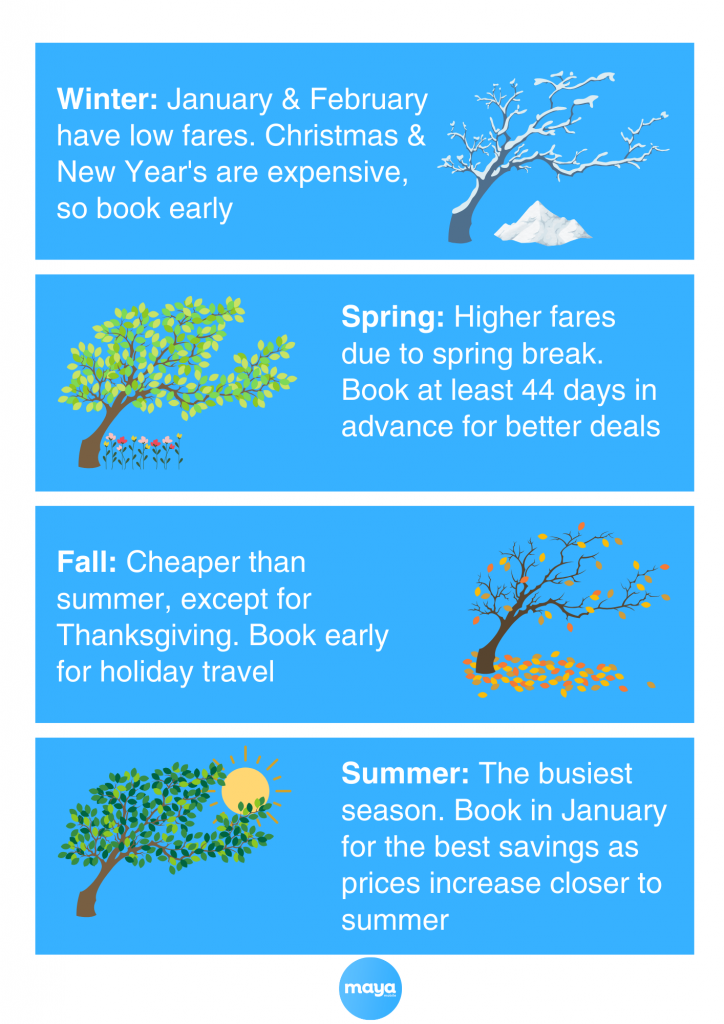Have you ever booked a flight only to find out later that someone else paid dramatically less for the same trip? It’s frustrating, but finding the cheapest days to book flights can make all the difference, helping you save significantly on your travels.
While many believe that booking on certain days guarantees cheaper fares, the reality is that airlines adjust their prices based on various factors, not just the day you book. This guide will help you pinpoint the cheapest days to book flights and get the most value for your money.
When is the Cheapest Day of the Week to Book a Flight?
Many believe booking flights on a specific day, like Tuesday, will guarantee cheaper prices. This idea came from a time when airlines used to release discounted fares on Tuesdays. However, this is no longer true.
Today, airlines use advanced systems that adjust prices constantly based on demand, competition, and other factors. This means there isn’t a single best day to book flights anymore. Prices can go up or down at any time, so it’s better to focus on other factors like timing and flexibility rather than waiting for a specific day of the week.
Additionally, understanding how airlines set their prices can give you an edge in finding the best deals. Let’s dive into the factors that influence these price changes.
How Demand Impacts Flight Prices
The key to finding cheaper flight booking days lies in understanding dynamic pricing. Airlines use complex algorithms to adjust ticket prices based on real-time demand. This means that prices can change rapidly throughout the week and even within a single day.
It is recommended that travelers monitor flight prices regularly and be prepared to book as soon as prices drop. Dynamic pricing often means that flash sales or limited-time discounts can appear unexpectedly, driven by fluctuations in demand. When demand drops, airlines may lower prices temporarily to fill seats.
Rather than waiting for a particular day, such as Tuesday, set up price alerts or use flight tracking tools to get notified when the best deals are available.
Tools to Find the Cheapest Days to Book Flights
There are various tools available that make it easier to track flight prices and find the best days to book. These platforms help you stay updated on price changes and even predict when fares are likely to rise or fall:
- Price Alert Tools: Platforms like Google Flights, Hopper, and Skyscanner allow you to set up price alerts for specific routes. These tools notify you when there are price drops, making it easy to spot limited-time deals.
- Flight Price Forecasting Tools: Websites like Google Flights and Kayak offer forecasting features that use historical data and pricing trends to predict whether a fare is likely to increase or decrease soon. This can help you decide whether to book immediately or wait for a better price.
- Price Tracking Tools: By regularly tracking flight prices over time, tools like Skyscanner and Momondo let you monitor how prices fluctuate on your desired route. This helps you identify patterns and take advantage of sudden price drops.
Now that you know which tools can help you monitor price trends, let’s discuss how far in advance you should book your flights to maximize savings.
Ideal Times and Days to Book Flights for Maximum Savings
While there is no specific ‘best day’ to book, there are certain periods and days of the week that can generally offer cheaper fares. Understanding when and how to book can vary depending on whether you’re flying domestically or internationally.
Domestic Flights
For domestic travel, it’s recommended to book flights 1 to 3 months in advance. During this period, airlines tend to offer reasonable fares as they try to balance filling seats without discounting them too heavily. If you book too early, prices may be higher because airlines know that early bookers are often less sensitive to price.
On the other hand, waiting until the last minute could lead to price hikes as demand for available seats rises. Additionally, the cheapest days to fly domestic are often midweek – typically Tuesday and Wednesday – when demand is lower. Flying on these days can help you save up to 15% compared to peak travel days like Sundays, which are usually the most expensive.
International Flights
For international travel, the ideal booking window is 2 to 8 months in advance. Booking during this time frame gives you a better chance of securing lower fares, especially for popular international destinations where last-minute prices can skyrocket. Booking early also helps lock in better deals during peak travel periods, such as summer and major holidays.
In terms of the cheapest days to fly internationally, Wednesday and Saturday tend to offer the best deals. These days see lower demand, particularly for long-haul flights. By flying on these less popular days, you could save up to 12% compared to flying on Friday or Sunday, which are the most expensive days for international travel.
Seasonal Considerations for Booking Flights
The season in which you travel also plays an important role in finding cheaper days to book flights. Certain seasons see higher travel demand, resulting in higher prices. Here are some seasonal tips:


By being aware of seasonal price fluctuations and avoiding peak travel times, you can optimize your savings even further.
Why Avoid Peak Travel Days
Peak travel days, especially around major holidays, can significantly increase the cost of flights. Christmas, Thanksgiving, and summer vacations are among the busiest travel times, and airlines tend to raise prices due to high demand. Avoiding peak days around these holidays can result in substantial savings.
For example, instead of flying out the day before Christmas or Thanksgiving, consider traveling on the holiday itself or the day after. Prices tend to drop for these less popular travel dates. Additionally, you can save by flying early in the morning or late at night, times when fewer travelers are likely to be booking flights.
To further optimize your travel savings, here’s a quick reference table that highlights the ideal booking windows, cheapest travel days, and the peak travel periods to avoid:
| Criteria | Details |
| Ideal Booking Window – Domestic Flights | 1 to 3 months in advance |
| Ideal Booking Window – International Flights | 2 to 8 months in advance |
| Cheapest Days to Fly – Domestic | Tuesday and Wednesday |
| Most Expensive Day to Fly – Domestic | Sunday |
| Cheapest Days to Fly – International | Wednesday and Saturday |
| Most Expensive Days to Fly – International | Friday and Sunday |
| Season with Cheapest Fares | Winter (January, February) |
| Peak Travel Days to Avoid | Major holidays like Christmas, Thanksgiving, and summer vacations |
Understanding these factors can help you make informed choices. Next, let’s explore how flexibility in your travel plans can lead to even greater savings.
Flexibility is Key to Finding the Best Deals
Being flexible with your travel plans is one of the most effective ways to find the cheapest days to book flights. Flexibility with travel dates, times, and even airports can open up a wider range of flight options at lower prices.
- Flexible Dates: When searching for flights, use the “flexible dates” option on platforms like Google Flights or Skyscanner. This allows you to view a calendar of fares for the entire month, helping you identify the cheapest days to book and fly.
- Alternate Airports: If you live near multiple airports, compare prices for flights departing from different locations. Sometimes, flying from a smaller or nearby airport can result in considerable savings.
- Flexible Destinations: If you’re open to different travel destinations, use a tool like Skyscanner’s “Everywhere” feature, which shows you the cheapest destinations to fly to from your departure airport. This can be a great way to discover new places while sticking to your budget.
Adopting flexibility in your travel plans expands your options and enhances your chances of securing the best deals, making your journey affordable and enjoyable.
Cheaper Days to Book Flights and Save More
Finding the cheapest days to book flights isn’t just about waiting for a magical Tuesday or obsessively tracking prices. It involves understanding airline pricing strategies, being flexible with your travel plans, and leveraging technology.
By flying on less popular days like Tuesday and Wednesday, booking within the optimal window, and avoiding peak travel times, you can significantly cut your airfare costs.
With Maya Mobile’s advanced eSIM technology, you can stay connected while monitoring flight prices and making last-minute bookings from anywhere. This ensures you can seize the best travel deals as they arise, keeping your journey smooth and hassle-free.
Related Reads
Smart Traveler’s Toolkit: Essential Apps for Seamless Journeys
Airport Tips for Traveling Like a Pro
FAQs on the Cheapest Days to Fly
What is the cheapest day to fly with Delta?
The cheapest days to fly with Delta are generally Tuesdays and Wednesdays. These midweek days tend to have lower demand, resulting in more affordable fares compared to peak travel days like Fridays and Sundays.
What are the airfare rules?
Airfare rules are the terms and conditions set by airlines for ticket purchases. These include details on cancellations, changes, refunds, baggage allowances, seat assignments, and any penalties for making adjustments.
What are the cheapest days to fly Southwest?
For Southwest flights, the cheapest days to fly are often Tuesdays, Wednesdays, and Saturdays. These days generally see lower demand, resulting in reduced fares compared to peak travel times.
In which month is the air ticket cheapest?
January and February typically offer the cheapest air tickets. These months see lower travel demand after the holiday season, making it an ideal time to find lower fares.
How do airlines set flight prices?
Airlines set flight prices using dynamic pricing algorithms. Prices fluctuate based on factors like demand, competition, booking time, season, and seat availability, with constant adjustments to maximize revenue and fill flights.
What time of day are flights cheapest?
Flights are typically cheapest during off-peak hours, such as early in the morning or late at night. These times, generally between 5 AM and 7 AM and after 8 PM, tend to have lower demand, which can result in cheaper fares.




